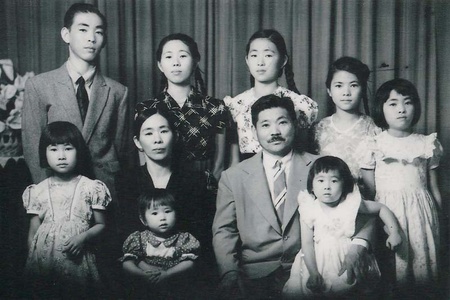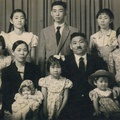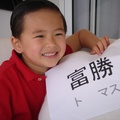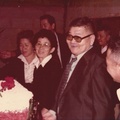My father came as an immigrant at the age of 16 with the family that adopted him, as he was a minor and needed to come as a member of another family. At that time, immigrants were treated like slaves. I heard that many fled or died. I don't know how my father freed himself from this slavery.
He worked tirelessly and sent money to his mother and brothers who had stayed in Japan. It was an extremely hard-earned amount (at that time, Brazilian money was highly valued in Japan).
One thing my father had a habit of was taking the whole family to take photographs in the first few days of January. And he sent this photo to his mother, so that she could reassure herself that her son was succeeding. He never imagined what his real situation was like in such a distant land. I admired my father, but I admired my mother even more, because she never objected to him sending that money.
I remember that at New Year's I received the only new outfit from my father, which one of my sisters made with cheap fabric. My father was the one who chose the color and pattern of the dress for each of us, as well as a new pair of shoes, which were big enough to wear all year round. In everyday life, she wore “ossagari”, which were her older sisters' worn-out clothes. I never saw a new dress in my childhood, except the OSHOGATSU dress. But I was happy, I didn't miss anything.
As life got better, my parents bought piglets that grew fat throughout the year. And at the end of the year, they killed the pigs, not wasting any part: the head and bones became soup, the leather and meat were fried very well and all the fat was removed and stored in large glass jars to be used in the preparation. of food.
My mother seasoned the meat in large pieces and fried it in her own fat and then kept it in a huge jar for us to enjoy for months. The fried leather was cooked together with the beans, becoming gelatinous, soft and tasty. The liver, heart, etc. they became delicious dishes and everything that was leftover became homemade soap. We didn't know market soap.
The part of the pig that could not be preserved, we enjoyed in the days before GANDITSU .
My father bought Guaraná soda and a whole piece of mortadella, which he left hanging from the ceiling so the rats couldn't access them.
We were waiting for the GANDITSU to arrive with great expectations, but as the family was large, we enjoyed a minimal portion, as most of it was reserved for visitors.
The day before, since dawn, the family was together to make GOTISSOU : SUSHI , MAKIZUSHI, INAKAMANDYU, YAKIMANDYU, FUKASHIMANDYU , etc. Needless to say, my mother made the ANKO in advance.
On the first day, my mother cooked the motigome and she and my father were paired at HOI HOI, in perfect tune, one hitting the USSU and the other passing water on the MOTIGOME .
I made several pots of “moti”. Then, with the dough still hot, we started making the dumplings. Imagine how many “motis” went into our mouth... “Motis” freshly made and still hot, only those who have tried it know how delicious it is. The “motis” were with and without “anko”.
Nowadays, the tradition still exists. In the neighboring city of Suzano, where my brother-in-law and a couple of nephews live, they do MOTITSUKI with USSU . Maybe they are already using “moti” devices.
Going back to my childhood, I couldn't miss those 3 “moti” balls, of different sizes, one on top of the other offered to KAMISSAMA .
My mother also did OZOUNI and we waited for visitors. My father said it would be good if the first visit was from a man, because it would bring luck. I was sad because I couldn't run out in the morning with new clothes and shoes to visit cousins and neighbors. Simply because I was a girl.
© 2015 Rosa Tomeno Takada






